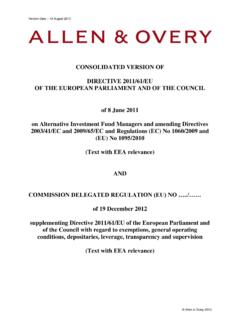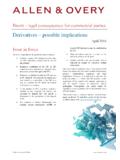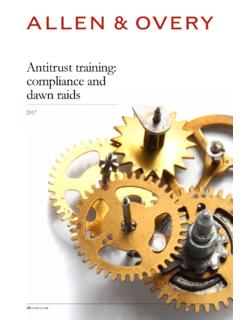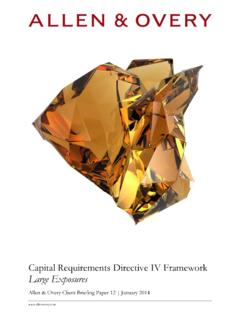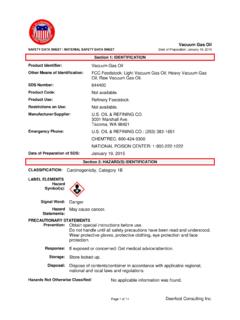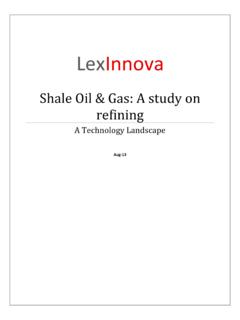Transcription of Guide to Extractive Industries Documents – Oil & Gas
1 To Extractive IndustriesDocuments Oil & GasWorld Bank Institute Governance forExtractive Industries ProgrammeSeptember 2013 Allen & Overy 2013 Contents1. Introduction 32. Key terms review 73. Key terms table 224. Glossary 26 Schedule 1 Example clauses 31 Contacts 382 Guide to Extractive Industries Documents Oil & Gas | September notion of the state sharing production of oil and gas with companies as part of a commercial enterprise was first developed in Bolivia in the 1950s. The Production Sharing Contract (PSC) was introduced in Indonesia in 1966 and PSCs are now used widely to record arrangements for oil and gas exploration and production, particularly in developing countries; today, they are used in over 40 countries, including in Africa, Central Asia and South-East PSC is not the only manner by which a state may grant oil and gas exploration and production rights to commercial investors.
2 Prior to the development of the PSC, exploration and production of oil and gas was typically governed by way of a licence or a concession, and these regimes remain in many jurisdictions (see paragraph below). However, in developing nations, the PSC is now the most common means by which a state permits commercial involvement in the oil and gas industry and in many jurisdictions there are political reasons for their adoption. For example, following Indonesian independence in 1945, the concessions regime came under attack by nationalist groups. This eventually led to the Indonesian government refusing to grant new concessions, which inevitably led to a decline in foreign investment in Indonesia s oil and gas sector. To halt this decline, the government introduced new legislation which provided for production sharing arrangements; such arrangements were widely considered to be less controversial than the previous concessions system, as they enabled the government to maintain formal ownership of the resources in question, while permitting the private sector to exploit is a PSC?
3 Under a PSC, a state (the State) contracts with an international (and in some cases a domestic or another state s national) oil company (IOC) for the IOC to provide the requisite finance and technical skills in order to explore for (and hopefully produce) oil and/or gas. The State will usually be represented by the government or a government body, such as the national oil company (NOC), who will take delivery of the State s share of production. The IOC is granted an exclusive right to explore and produce oil and gas within a defined area (generally known as the contract area) and, in doing so, bears the entire risk of the project, financial and otherwise. Should a commercial discovery be declared, the IOC becomes entitled to a portion of any oil produced as payment for its efforts (generally at the end of the quarter in which the oil is produced), in addition to recouping its costs out of production; conversely, if no discoveries are made, the IOC receives nothing.
4 The State retains ownership of all oil and/or gas produced (subject only to the IOC s entitlement to a portion of any oil produced on a successful discovery). The extent to which the NOC is involved with the exploration and production process varies from country to Allen & Overy are very grateful to Professor Terence Daintith for his contributions to this Allen & Overy 2013 There are commonly four key financial aspects to a PSC:(a) Royalty: Firstly, the IOC is often expected to pay a royalty on gross production to the State. The royalty is often, at the State s election, taken in kind (that is, a share of production) or by way of a payment equivalent to the sale price of the State s royalty share of production.(b) Cost oil: Following payment of any royalty, the IOC is entitled to a pre-determined percentage of production from which it may recover its costs (with any costs not recovered carried forward to the next period).
5 Such production is known as cost oil.(c) Profit oil: The oil remaining after the royalty and cost oil (known as profit oil) is divided between the IOC and the State in accordance with the production sharing provisions in the PSC. It is often the case that the State s share of profit oil increases as production increases.(d) Income tax: Finally, the IOC usually has to pay income tax on its share of profit oil. However, this income tax is often paid by the NOC or State on behalf of the IOC, such that there is no financial impact on the terms of the respective parties objectives in negotiating a PSC, generally an IOC will want to negotiate for itself as much control as possible over operations, and it will want any State intervention in the running of the project kept to a minimum. Naturally, it will be keen to keep its costs low, by negotiating favourable tax provisions and the ability to recover some (if not all) of its costs.
6 The State s primary interests are financial; it wants to make the maximum profit possible and have access to an IOC s resources and relevant expertise, by expending minimal time and money. It will also want to ensure that the IOC is undertaking a sufficient work program (including meeting a minimum level of expenditure) and that the land is being used efficiently. The State may also have national economic considerations that it wishes to address; for example, it may want to ensure that domestic supply is met from any production of oil and/or gas. In addition, the State will typically be concerned to secure as many rights and benefits for the local community as possible, for example, jobs and training for local workers and access to medical the PSC model?The obvious advantage of the PSC model for the State is the minimal risk on its part; it is able to reap the benefits of its natural resources without having to spend its own time and money.
7 In many cases, the State may not have the technology needed to explore for and produce oil and/or gas and so enlisting the help of an IOC who has the requisite technology is usually necessary in order for the State to exploit its natural exploration prove successful, the State can secure a long-term supply of oil and/or gas. The long term nature of PSCs enables States to predict future levels of oil and gas for domestic use and budget accordingly. Alternatively, the PSC model can be very financially lucrative for the State; it is often the case that it has the option of taking its share of production as a payment, rather than in kind. It is also very common for PSCs to provide that as production increases, the proportion attributable to the State also increases, meaning that a significant proportion of the value of profit oil is paid to to Extractive Industries Documents Oil & Gas | September is clear that the IOC, at least in the initial stages of an oil and/or gas project, is the party who bears substantially all of the financial risk.
8 However, should exploration prove successful, the IOC should be able to recover its costs through cost oil (see paragraph ) and share in the profits of the remaining quantity of oil and/or gas. In this regard, in theory at least, the PSC model is more favourable to the State than to IOCs in contrast to the concessions system. However, this of course depends entirely on the financial terms negotiated; it may be possible for an IOC to negotiate a PSC with more financially attractive terms for it than a concession may offer in neighbouring possible negative aspect of the PSC model is that it is contractual; under the PSC model, the State always remains the owner of the resources, with the contract establishing the applicable compensation arrangements and level of NOC or State involvement in the asset. PSCs can allow States to provide a more extensive framework in respect of the relevant asset and, in general, they tend to afford IOCs less freedom to run an asset, with Contractors being subject to restrictions and required approvals in addition to those contained in the applicable legislation and are a number of alternatives to the PSC model.
9 The differences in these alternatives lie mainly in relation to the level of control granted to the IOC, the level of involvement of the NOC, and the compensatory arrangements.(a) Licence: Under this arrangement, there is little scope for an IOC to negotiate tailored arrangements in relation to its exploration and production rights. Licensing regimes are typically standardised and embedded in legislation, such that the terms of each licence are near identical. This regime is most common in developed countries UK, Norway, the Netherlands, Australia. The IOC is typically granted complete control over the contract area and complete ownership over any oil and gas it successfully produces. Unlike PSCs, where ownership of the resources always remains with the State, in licence regimes ownership generally passes at the wellhead, with profits subject to general tax legislation.(b) Concession: A concession arrangement is generally subject to a greater level of negotiation than a licence.
10 The IOC is typically granted proprietary rights over the contract area and complete ownership over any oil and gas it successfully produces, subject to the payment of a royalty and income tax (each of which may vary in rate depending on the level of production).(c) Service contract: Under a service contract, the IOC provides its technical services to the State to explore and develop oil and gas resources and so in many ways it is similar to a PSC. However, remuneration to the IOC is usually by way of a service fee or payments based on the value of oil produced. The term of a services contract is often very short, leaving an IOC with considerable risk and no guarantee of a long production period (although we note that services contracts may also be on a non-risk basis). Services contracts are common in Iran, Iraq and Kuwait and have also been used from time to time in Allen & Overy 2013(d) Joint venture: This is not strictly an alternative to the PSC model, but such an arrangement may be used in conjunction with a PSC, a concession or a service contract.

